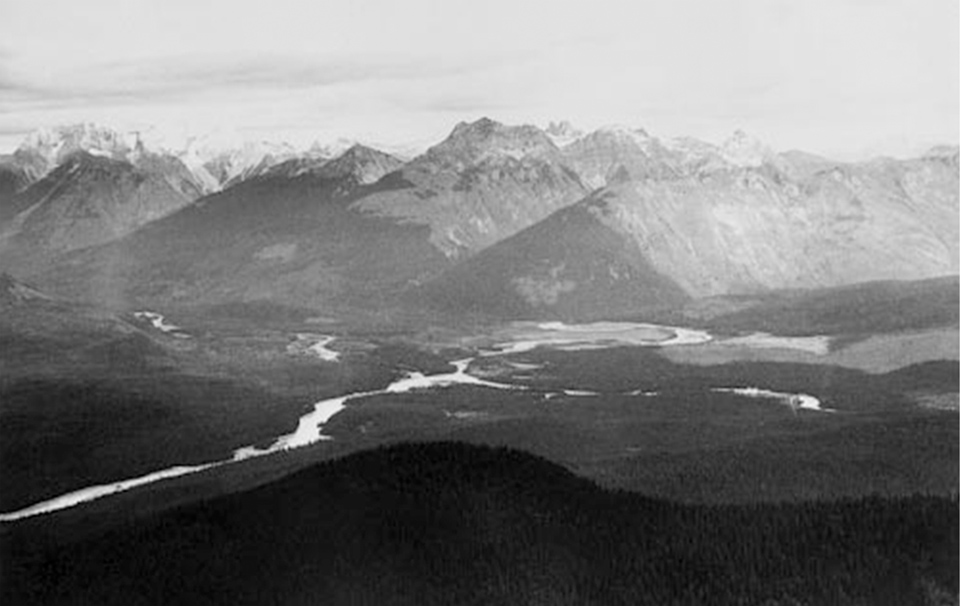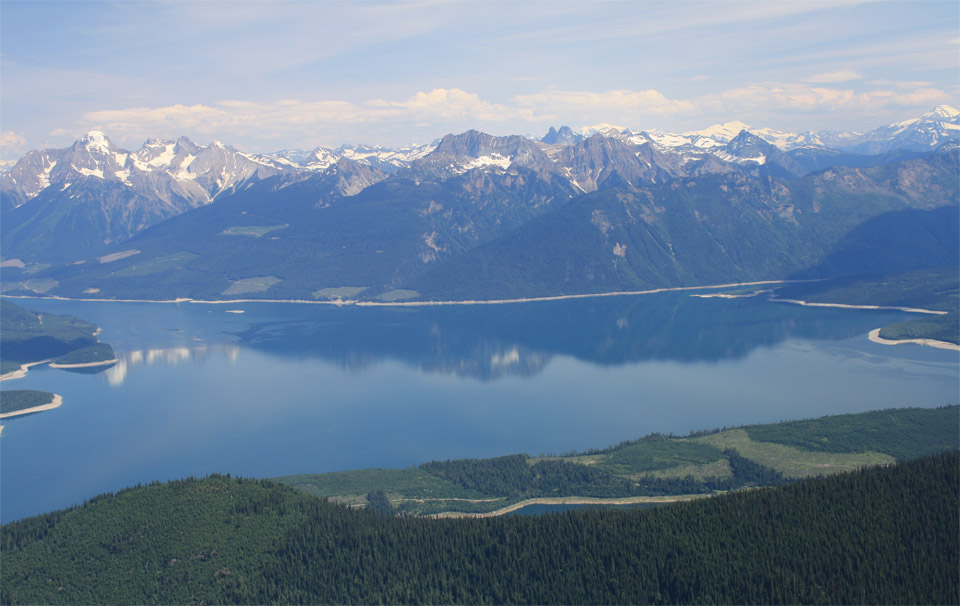View from Fred Laing Ridge of Boat Encampment at the confluence of the Canoe (from upper left), Wood (from upper right), and Columbia (centre right) rivers in 1947 (Rey Marr, 1947 Whyte Museum of the Canadian Rockies) and in 2010 (CW-2010-07-11-042). Through straight incompetency, I forgot my binder of paper photographs on this trip up to Mica Creek, so I tried to reshoot this picture while holding my laptop computer up for comparison and hiding under a jacket for shade from bright morning sun so that I could see the screen (sort of). Looks I was too high on the ridge by about 500 meters. Anybody interested in redoing this, please Email me, and I’ll send you a JPEG. Its a nice hike up Fred Laing Ridge on a good trail. The dog loved it. I am still irked.
In January, 1811 David Thompson’s party bringing trade goods over the Rockies descended the Wood River watershed from Athabasca Pass to reach the Columbia River at what they called “Boat Encampment”. Caught by cold weather and deep snow, the fur traders spent the three months here. Their campsite is now submerged under the massive reservoir behind the Mica Dam.
January 1811: David Thompson Crosses Athabasca Pass to the Columbia River
On January 6, 1811 David Thompson’s horse pack-train of trade goods bound for the western slopes reached “Prairie de la Vache”, one of the last meadows in the upper Athabasca Valley upstream of Jasper:
“where we put up there area few small Ponds & Marshes that bear long Grass. Here a herd of Buffalo had been lately feeding: (the hunters) wounded a Bull only slightly. Here we must leave the Horses, as the Road futher is unfit for them & there is no food.” 1
From here the traders snowshoed along a trail traditionally used by Salish peoples crossing the mountains from the west to hunt bison, and more recently by Iroquois trappers. They carried their provisions by dog sled and backpacks up the Whirlpool River, crossing over Athabasca Pass, and descending the steep slopes to reach the ice-choked Columbia River on January 23. This was an extremely rugged trip in deep snow with cold temperatures. Thompson reported that his dispirited, hard-working voyageurs were voraciously hungry: “they eat at the rate of about 8 lbs per day of pure Meat.” 2
At Boat Encampment on the “Big Bend”, where the Columbia River swings from a northern to a southern course, Thompson’s group built a twelve by twelve foot hut and waited for the river to open up in the spring. His winter waiting at Boat Encampment allowed him to make his usual detailed observations on the landscape’s ecology which he later summarized in his famous “Narrative”:
“Moose Deer and Beaver were plentiful and the mildness of the climate, and large supply of water induced many of them to build slight houses, or to live on the banks of the River and it’s many Brooks ; these two streams, at the foot of the hills have formed a wide alluvial, on which are forest Trees of enormous size ; the white Cedars were from fifteen to thirty six feet girth; clean grown and tall in proportion, numbers were of the largest size, and in walking round them they appeared to have six or eight sides. The pines were from eighteen to forty two feet in girth, measured at ten feet above the ground, which the snow enabled us to do. They were finely formed, and rose full two hundred feet without a branch, and threw off very luxuriant heads; the white Birch was also a stately Tree, tall and erect, but none above fifteen feet girth and these were few ; what appeared remarkable these gigantic Trees did not intermix with each other. The Birch was distinct from the others, neither Pine nor cedar grew among them; next to the Birch was the Cedar, with scarce a Pine amongst them, and then the Pine Forest with very few Cedars; these Forests did not extend beyond these alluvials.” 3
During the next few months, Thompson’s group was likely saved from starvation by the abundance of moose. Increasing moose numbers was a major change that was just, in the early 1800s, beginning to sweep westwards across today’s British Columbia. Although the cause of the major bio-geographical change is still debated, it is likely that First Nations had kept moose numbers very low for many thousands of years. This was particularly true near salmon-bearing streams where human numbers were high and the need for fat and hides the greatest. However, after the smallpox epidemic in the late 1700s, reduced numbers of humans retreated to core villages lower on the Columbia River, and human use declined in remote areas with deep winter snows. Moreover, with reduced populations, the number of Salish people crossing the continental divide into the Jasper area to hunt bison declined, and the Athabasca Pass area was, for much of the 1800’s a lightly hunted buffer zone between expanding Cree and Metis populations on the eastern slope and western slope peoples. By the early 1900s, moose expanded westwards across much of British Columbia, and its numbers went from rare to abundant. 4
The repeat photographs of the Big Bend area show amazing landscape change. The early photograph shows, near the river, the limited areas of tall, large trees described by Thompson. The steeper, well-drained slopes, as with most western landscapes, show evidence of frequent forest fires. In the forests of the northern Columbia River that are snow-covered much of the year, these high intensity burns occurred during relatively common periods of mid-summer drought and high temperatures. Due to lightning and human ignitions, fire frequency was surprisingly high with estimates ranging from 50 to 100 years prior to the mid to late 1700s. Two declines in fire activity occurred thereafter, one around 1750 to fire cycles of 100 to 150 years, and the recent, most significant decline in burn area resulting in fire cycles exceeding 1000 years. Because of its remoteness, this recent, highly effective suppression of fires near the Boat Encampment did not occur until the 1940s when the Big Bend Highway was completed. The earlier inflection point may be tied to climate change and perhaps the impact of diseases on native populations, and hence the probability of ignitions. Today, the dominant source of forest disturbance in the area is through timber harvesting in the large areas of forests now reaching maturity through lack of fire. 5
In 1973, the British Columbia government finished the Mica Dam as part of its commitments to complete the Columbia River Treaty projects that impound almost all the river. Mica inundated the area of Boat Encampment in a reservoir over 100m deep, with arms of the lake reaching far up the Canoe, Wood, and upper Columbia valleys. Major areas of the valley bottom habitat that fed the moose that saved David Thompson’s party have now disappeared.
By late March, 1811 Thompson was building a boat of cedar planks to move the trade goods southwards to the North West Company’s trading posts in today’s northern Washington, Idaho, and Montana. Surprisingly, once the Columbia River did begin to open up, he did not paddle downstream. With little knowledge of the river’s rapids in this direction, and only a small remaining crew of voyagers, Thompson decided to take safer course of moving back upstream to the upper Columbia valley to Kootenae House along routes where he knew the trails and river hazards. By late May he had ascended the Columbia, descended the Kootenay, and brought the important shipment of trade goods to the trading posts on the Clark Fork River.
Map and References
- Belyea, B., ed. Columbia Journals: David Thompson. Montreal and Kingston: McGill-Queen’s University Press, 1994, pp: 134-135. ↩
- Belyea, Columbia Journals, 136. ↩
- Tyrell, J. B., ed. David Thompson’s Narrative of his Explorations in Western America 1784-1812. Toronto: Champlain Society, 1916 ↩
- Hatter, J. 1950. The Moose of Central British Columbia. PhD. thesis. State College of Wash., Pullman, WA. 356pp.; Kay, C. E. “Aboriginal Overkill and the Biogeography of Moose in Western North America.” Alces 32 (1997): 1–24. ↩
- Johnson, E.A., G.I. Fryer, and M.J. Heathcott. 1990. “The Influence of Man and Climate on Frequency of Fire in the Interior Wet Belt Forest, British Columbia.” Journal of Ecology 78 (1990):403-412; Stocks, B.J., J.A. Mason, J B. Todd, E.M. Bosch, B.M. Wotton, B.D. Amiro, M.D. Flannigan, K.G. Hirsch, K.A. Logan, D.L. Martell, and W.R. Skinner. 2003. Large forest fires in Canada, 1959-1997. Journal of Geophysical Research 107 (2003): 8149; White, C.A., D.D.B. Perrakis, V.G. Kafka, and T. Ennis.”Burning at the Edge: Integrating Biophysical and Eco-cultural Fire Processes in Canada’s Parks and Protected Areas.” Fire Ecology 7(2011): 74-106. doi: 10.4996/fireecology.0701074. ↩

